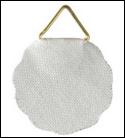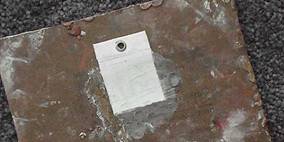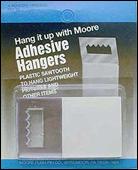 Photo 1
Photo 1
Hama Hanger
Just this week I have answered two email queries from encaustic artists about hanger options for unframed panels. I first addressed this issue back in March 2011 when I suggested that all panels should be framed—and I still believe that, because frames are designed to protect the art and panel edges from potential damage if dropped or falls. That said, let's take a look at what might be offered as alternative hanging hardware when a panel must be left unframed.
Linen Hangers
Commercial linen hangers with a metal eyelet, grommet, or triangle are a possible choice for adhering to the back of an unframed panel as the fabric will not tear but the hanger is only as strong as the metal attachment itself. Hama Hangers are small 1" scalloped round tabs with a split metal triangle at the top, not very strong and not advised for art panels (photo 1).
 Photo 1
Photo 1
Hama Hanger
Ook Eyelet Hangers are sold in hook/eyelet pairs but the eyelet is the half to be used (photo 2). They have a water-activated adhesive supporting up to 3 lbs. Since the substrate (panel) must be absorbent, dry, free of dust and grease it is ill-advised to use water activated adhesive opting for commercial adhesive or wax medium. This should increase bonding potential and add to weight tolerance, but long term effects of chemical adhesives on the painting are unknown.
 Photo 2
Photo 2
Ook Eyelet Hanger fused with wax medium.
Plastic Hangers
In general not the best idea for panels. Plastic, self-adhesive, sawtooth hangers—referred to as foam board hangers in the framing industry—are designed to suspend lightweight backing boards that are not framed. Hangers are available in assorted shapes—round, triangular, sawtooth—and sizes from a number of sources including Ook, Moore and Zig-Zag. Obviously if suspended from a single hanger the location of the hanger must be in actual balance center rather than mathematical center, and with an encaustic panel that is more difficult to determine. So the better choice might be sawtooth.
 Photo 3
Photo 3
Plastic sawtooth hangers are pressure-sensitive adhesive.
The pressure-sensitive adhesive on plastic hangers is very light-duty and not designed to hold more than 1 lb per hanger with a maximum of 2 hangers used. Never reuse a self-adhesive hanger after removing as they are intended for one-time use only. Do not use wire in combination with plastic hangers, as it can gradually slice through the plastic over time. If you want to use wire then small D-rings and small screws should be used.
Though designed as peel and stick pressure-sensitive adhesive, in order to activate up to 80% of the adhesive it requires aggressive burnishing which is difficult through thick plastic. Direct pressure or rubbing will only activate about 20%.
The pressure-sensitive adhesive bond improves as it cures reaching maximum bond in 24-48 hours, but the adhesive will not hold to treated or wax soaked panels.
I may not agree with everything an artist wants to do when displaying their art, but I am always here to help. Regardless of whether it is an advised practice or not, I will always try to give you the best solution within your set restrictions for your framing situation.
END
Copyright © 2012 Chris A Paschke
For more articles on mounting basics look under the mounting section in Articles by Subject.
There is a special section in the library for all past IEA Framing Matters articles from Wax-On!
Additional information on all types of mounting is found in:
The Mounting and Laminating Handbook, Second Edition, 2002,
The Mounting And Laminating Handbook, Third Edition, 2008 and
Creative Mounting, Wrapping, And Laminating, 2000 will teach you everything you need to know about getting the most from your dry mount equipment and materials as an innovative frame designer.
All books are available from Designs Ink Publishing through this website.
Chris A Paschke, CPF GCF
Designs Ink
Designs Ink Publishing
785 Tucker Road, Suite G-183
Tehachapi, CA 93561
P 661-821-2188
chris@designsinkart.com